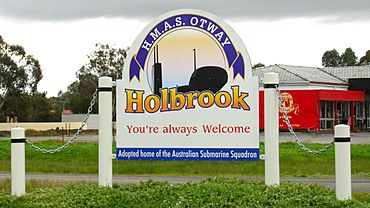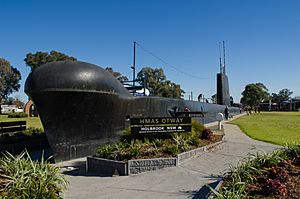Holbrook, New South Wales facts for kids
Quick facts for kids HolbrookNew South Wales |
|||||||||||||||
|---|---|---|---|---|---|---|---|---|---|---|---|---|---|---|---|

Holbrook town entry sign
|
|||||||||||||||
| Population | 1,715 (2016 census) | ||||||||||||||
| Established | 1836 | ||||||||||||||
| Postcode(s) | 2644 | ||||||||||||||
| Elevation | 289 m (948 ft) | ||||||||||||||
| Location |
|
||||||||||||||
| LGA(s) | Greater Hume Shire Council | ||||||||||||||
| County | Goulburn | ||||||||||||||
| State electorate(s) | Albury | ||||||||||||||
| Federal Division(s) | Farrer | ||||||||||||||
|
|||||||||||||||
Holbrook is a small town in Southern New South Wales, Australia. It is located on the Hume Highway, a major road connecting big cities. Holbrook is about 384 kilometers (239 miles) northeast of Melbourne. It is also about 492 kilometers (306 miles) southwest of Sydney. The town is found between Tarcutta and Albury.
Holbrook is part of the Greater Hume Shire. This area was formed in 2004 by joining several smaller shires. In 2016, about 1,715 people lived in Holbrook. The land around Holbrook is known for its farms. Farmers here produce merino wool, wheat, and other grains. They also raise lucerne, cattle, and lambs.
Contents
Holbrook's History
Holbrook is on the traditional lands of the Wiradjuri people. They are the original owners and caretakers of this land.
The first known Europeans to explore this area were Hume and Hovell. They traveled through in 1824. They were looking for new places for farm animals to graze.
How Holbrook Got Its Name
The town was first called Ten Mile Creek. The first buildings were put up in 1836. A German immigrant named John Christopher Pabst opened a hotel in 1840. Because of him, the area became known as "the Germans." By 1858, this name changed to Germanton.
During World War I, many people felt angry towards Germany. So, on August 24, 1915, the town's name was changed. It was renamed Holbrook to honor Lieutenant Norman Douglas Holbrook. He was a brave submarine captain. He even won a special medal called the Victoria Cross. Lieutenant Holbrook commanded a submarine named HMS B11.
Holbrook was once an important stop on the Old Sydney Road. This road connected Sydney and Melbourne. A railway line reached Germanton in 1902. However, the railway line closed in 1975. In 2013, the Hume Highway was changed. Now, drivers can go around Holbrook instead of through the town.
Garryowen Settlement
Garryowen was a small settlement and property. It was located about 13 kilometers (8 miles) northeast of Holbrook. This was in the mid-1800s. There were plans for a bigger town there, but it was never built.
Sports in Holbrook
The most popular sports in Holbrook are Australian rules football, cricket, and netball.
The Holbrook Football Netball Club started in 1882. It joined the Hume Football Netball League in 1999. The club has won championships in 2002 and 2022.
Holbrook also has a Cricket Club. They play in the local district league.
The Holbrook Rugby League Club was active from the 1930s until 1991. They were known as the Warriors and Bears. They were a successful team in the 1950s and 1960s.
Local Landmarks
HMAS Otway Submarine
To honor Lieutenant Holbrook, the town decided to get a part of a submarine. They acquired a piece of the HMAS Otway submarine. The Otway was an Oberon-class submarine. It was taken out of service by the Royal Australian Navy in 1995.
The Navy gave the submarine's fin to the town. This inspired the town to raise money to buy the whole submarine. They successfully raised $100,000. Most of this money was a gift from Lieutenant Holbrook's widow, Gundula Holbrook.
However, this amount was not enough to buy the entire submarine. After talking with the scrap yard, the town managed to buy the outside part of the Otway that was above the water. This part of the Otway is now on display. You can see it in Germanton Park, right in the middle of Holbrook. It was officially opened on June 7-8, 1997.
National Museum of Australian Pottery
The National Museum of Australian Pottery is located in an old building. It used to be the A. H. Mackie and Company building. The museum has over 1,500 pieces of pottery. These pieces were made from the earliest days of Australian settlement until the end of World War I.
Climate
| Climate data for Holbrook(Lat: 35.72° SLon: 147.31° E) (precipitation normals 2000-2024) | |||||||||||||
|---|---|---|---|---|---|---|---|---|---|---|---|---|---|
| Month | Jan | Feb | Mar | Apr | May | Jun | Jul | Aug | Sep | Oct | Nov | Dec | Year |
| Average precipitation mm (inches) | 56.8 (2.24) |
55.8 (2.20) |
58.6 (2.31) |
42.4 (1.67) |
48.4 (1.91) |
65.5 (2.58) |
61.1 (2.41) |
65.5 (2.58) |
59.3 (2.33) |
56.5 (2.22) |
70.2 (2.76) |
46.0 (1.81) |
686.1 (27.02) |
| Source: Bureau of Meteorology | |||||||||||||
Notable People from Holbrook
- Charlie Armstrong (1883–1954), an Australian rules footballer.
- Noel Barnett (1908–2000), an Australian rules footballer.
- Richard Bull (born 1946), a farmer and former politician in the state government.
- Sophie Casey (born 1991), an Australian rules footballer.
- Anne Clyde (1946–2005), an Australian educator, teacher-librarian, and author.
- Allan Ewing (born 1951), a retired Anglican bishop who worked in Holbrook.
- Alfred Geary (1849–1911), a cricketer.
- James Gormly (1836–1922), a politician in the state government.
- Jim King (1873–1929), an Australian rules footballer.
- Jack Loes (1910–1982), an Australian rules footballer.
- Gordon McLaurin (1862–1917), a politician in the state government.
- James McLaurin (1821–1891), a politician in the state government.
- John Meredith (1920–2001), important in bringing back Australian folk music in the 1950s.
- Daniel Morgan (1830–1865), a famous bushranger who visited the town in 1864.
- Alyce Parker (born 2000), an Australian rules footballer.
- Henry Playfair (born 1983), an Australian rules footballer.
- Bruce Quick (born 1959), an Australian Olympic and Commonwealth Games shooter.
- Ellis Stones (1895–1975), an Australian landscape architect. He designed many gardens, including 'Kildrummie' in Holbrook.
- George Withers (1917–1991), an Australian rules footballer.
Images for kids












